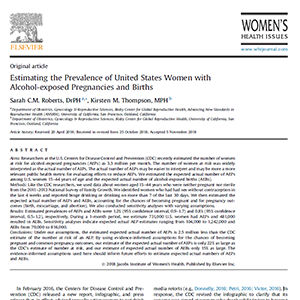 In 2016, the Centers for Disease Control released a report that advised sexually active women not to drink alcohol unless they were using contraception. After a public outcry, they clarified that their concern was aimed at women drinking while trying to become pregnant, sharing their estimate that about 3.3 women each month are at risk for alcohol-exposed pregnancies (AEPs). We used the same dataset as the CDC to estimate the expected actual number of AEPs using a more specific set of assumptions, including three pregnancy outcomes - birth, miscarriage, and abortion - and the chances of becoming pregnant from unprotected sex.
In 2016, the Centers for Disease Control released a report that advised sexually active women not to drink alcohol unless they were using contraception. After a public outcry, they clarified that their concern was aimed at women drinking while trying to become pregnant, sharing their estimate that about 3.3 women each month are at risk for alcohol-exposed pregnancies (AEPs). We used the same dataset as the CDC to estimate the expected actual number of AEPs using a more specific set of assumptions, including three pregnancy outcomes - birth, miscarriage, and abortion - and the chances of becoming pregnant from unprotected sex.
We found that the estimated expected number of AEPs in the United States is about 2.5 million less than the CDC researchers’ estimate of women “at risk” for an alcohol-exposed pregnancy. These findings do not question the importance of alcohol consumption during pregnancy as a public health problem, but instead emphasize concern over the ramifications of misinterpreting the scope of this problem, which could include leading to enactment of stigmatizing and punitive policy approaches that lead to poor health outcomes.
More realistically accounting for conception probabilities and all pregnancy outcomes (birth, miscarriage, and abortion) is imperative to reach a more accurate estimate of AEPs. The authors argue that basing estimates on the best available scientific evidence is crucial, even when these data include “controversial” topics such as abortion.
Read the full publication, "Estimating the prevalence of United States women with alcohol-exposed pregnancies and births," at Women's Health Issues.
